-
California’s future: More frequent and more severe droughts and floods
In the future, the Pacific Ocean’s temperature cycles could disrupt more than just December fishing. A new study suggests that the weather patterns known as El Nino and La Nina could lead to at least a doubling of extreme droughts and floods in California later this century.
-
-
Technology confronts disasters
In 2010, soon after Haiti was devastated by an earthquake, a team from MIT Lincoln Laboratory collected and analyzed information to help the U.S. Southern Command (USSOUTHCOM), the lead military agency responding to the crisis, effectively dispatch vital resources, including food, water, tents, and medical supplies, to the victims of this disaster. This Haiti experience demonstrated to Lincoln Laboratory researchers that advanced technology and technical expertise developed for the Department of Defense (DoD) can significantly benefit future humanitarian assistance and disaster relief efforts. In February, the Laboratory established the Humanitarian Assistance and Disaster Relief (HADR) Systems Group to explore ways to leverage or advance existing capabilities for improving disaster responses.
-
-
U.K. bolsters flood defenses
In 1953, more than 300 people died in the United Kingdom alone when heavy storms swept a high spring tide over sea defenses and across coastal towns in north-east England and Scotland. Today floods still make headlines but our ability to limit their effects has come a long way. Flooding costs the United Kingdom £2.2 billion a year in defenses and repairs, and annual spending must keep growing just to maintain present defenses. That is a massive investment, but history — and recent history at that — shows that the risk of flooding should not be underestimated.
-
-
Philippines coastal areas go underwater due to sea level rise
More than 167,000 hectares of Philippines coastland — about 0.6 percent of the country’s total area — are projected to go underwater in, especially in low-lying island communities, according to research by the University of the Philippines. Low-lying countries with an abundance of coastlines are at significant risk from rising sea levels resulting from global warming. According to data by the World Meteorological Organization, the water levels around the Philippines are rising at a rate almost three times the global average due partly to the influence of the trade winds pushing ocean currents. On average, sea levels around the world rise 3.1 centimeters every ten years. Water levels in the Philippines are projected to rise between 7.6 and 10.2 centimeters each decade.
-
-
Managing urban stormwater runoff better
As meteorologists monitor the El Nino condition currently gaining strength in the Pacific Ocean, Californians look with hope to the much-needed rain and snow it could yield. But if Californians are going to make the most of the precipitation, they need to put a LID on it. LIDs, or low-impact development technologies, mimic pre-urban stream functions. Examples are green roofs that absorb and evapotranspire rainfall; rainwater tanks attached to homes and other buildings; and permeable pavement for roads, driveways and parking lots. Rainwater could even be used in the home for toilet flushing and laundry.
-
-
Vermont and Colorado as case studies for flood hazards
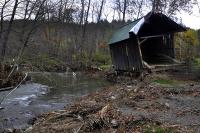
Catastrophic floods in 2011 in Vermont and 2013 in Colorado devastated many communities. While flood waters were the highest in recorded history, much of the damage done by these floods was not related to inundation by flood water, but instead caused by abundant erosion and sedimentation. These floods provided a rare opportunity better to understand controls on the locations of these different hazards.
-
-
IPCC projections “wildly over optimistic”: Climate expert
As a new chairman is appointed to the Intergovernmental Panel on climate Change (IPCC), one climate expert has said headline projections from the organization about future warming are “wildly over optimistic.” The expert says that IPCC claims that “global economic growth would not be strongly effected” are unrealistic and that if we are to meet the 2°C warming target, wealthy and high emitting individuals will need to make dramatic cuts in the energy they use and in the material goods they consume at least until the transition away from fossil fuels is complete.
-
-
Sea level rise dooms Miami, New Orleans
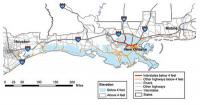
Say goodbye to Miami and New Orleans. No matter what we do to curb global warming, these and other beloved U.S. cities will sink below rising seas, according to a new study. “In our analysis, a lot of cities have futures that depend on our carbon choices but some appear to be already lost,” says one of the study’s authors. “And it is hard to imagine how we could defend Miami in the long run.” An online tool shows which U.S. cities may face “lock-in dates beyond which the cumulative effects of carbon emissions likely commit them to long-term sea-level rise that could submerge land under more than half of the city’s population,” said the study.
-
-
Global marine analysis: Food chain collapse likely
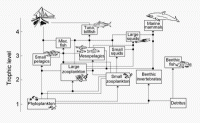
A world-first global analysis of marine responses to climbing human CO2 emissions has painted a grim picture of future fisheries and ocean ecosystems. Marine ecologists say the expected ocean acidification and warming is likely to produce a reduction in diversity and numbers of various key species that underpin marine ecosystems around the world. The researchers found that there would be “limited scope” for acclimation to warmer waters and acidification. Very few species will escape the negative effects of increasing CO2, with an expected large reduction in species diversity and abundance across the globe.
-
-
What we need to know about living in an era of extreme events
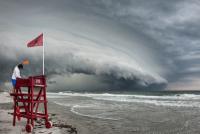
The recent flooding in South Carolina is yet another reminder of just how much destruction natural disasters can cause and how ill prepared communities throughout the United States continue to be. Extreme events such as flooding, drought, and storms are leading to not only short-term economic and health impacts but are setting the stage for significant struggles for future generations. A multi-disciplinary seminar explored what we have learned from past events and what the latest science tells us about the future of disaster preparedness, response and recovery.
-
-
DYI experiment demonstrates the physics of climate change for students

There are two main causes of rising sea levels — thermal expansion and melting land-based ice. Thermal expansion is responsible for most of the rising sea levels during the past century, but an increasing amount of rising levels into the future will be due to the melting Greenland and Antarctic ice sheets, as well as melting glaciers across the globe, especially the Himalayas, experts say. The rising sea level is a global phenomenon and will affect all coastal cities, but some places are more vulnerable than others. For example, the sea level on the North American Atlantic coast north of Cape Hatteras is rising three to four times faster than the global average, which has been attributed to a reduction in the strength of the Atlantic Meridional Overturning Current.
-
-
Understanding monsoons for better predictions of Indian weather
Summer, or southwest, monsoons are moisture-soaked seasonal winds that bring critical rainfall to the Indian subcontinent during the June-September wet season. An abundant season provides sustaining rainfall that replenishes water reservoirs and reaps bountiful crop harvests. By contrast, a weak season could lead to drought, soaring food prices and a battered economy. Better to understand global weather patterns and increase scientific collaboration between the United States and India, researchers have completed a month-long cruise studying summer monsoon conditions in the Bay of Bengal.
-
-
Water security test bed to focus on bolstering municipal water security
Water is the foundation for life. People use water every single day to meet their domestic, industrial, agricultural, medical, and recreational needs. After the September 2001 terrorist attacks, water system security became a higher priority in the United States. The Water Security Test Bed (WSTB) at Idaho national Laboratory can be used for research related to detecting and decontaminating chemical, biological, or radiological agents following an intentional or natural disaster. The WSTB will focus on improving America’s ability to safeguard the nation’s water systems, and respond to contamination incidents and to natural disasters.
-
-
To “see” climate change, check your thermometer

Scientists often use satellites, supercomputers, or high-tech arrays of instruments to show how the climate is changing. But now researchers have shown how climate change can be visible, even at just one location, with the simplest instrument of all: a thermometer.
-
-
Climate change will soon make atolls in the Pacific, Indian oceans uninhabitable
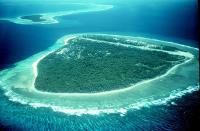
More than half a million people live on atolls throughout the Pacific and Indian Oceans. A new study shows that the combined effect of storm-induced wave-driven flooding and sea level rise on island atolls may be more severe and happen sooner than previous estimates of inundation predicted by passive “bathtub” modeling for low-lying atoll islands, and especially at higher sea levels forecasted for the future due to climate change.
-
More headlines
The long view
The Surprising Reasons Floods and Other Disasters Are Deadlier at Night
It’s not just that it’s dark and people are asleep. Urban sprawl, confirmation bias, and other factors can play a role.
Why Flash Flood Warnings Will Continue to Go Unheeded
Experts say local education and community support are key to conveying risk.
